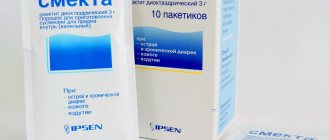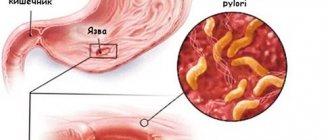The article was prepared by a specialist for informational purposes only. We urge you not to self-medicate. When the first symptoms appear, consult a doctor.
If you have stomach pain or diarrhea, you should consult a doctor. It is quite difficult to independently determine the causes of such health problems.
Diarrhea and abdominal pain may be symptoms that indicate a disorder in the functioning of the digestive system, or may simply occur due to overeating or stress. Even simple physical stress can cause nausea and abdominal pain.
Sometimes these unpleasant symptoms appear unexpectedly for a person and also disappear unexpectedly for him, without any treatment. However, things don't always end so well. Often the patient requires medical attention.
Causes of nausea, abdominal and head pain
A healthy person cannot experience situations in which he feels sick, has a stomach ache, or has a headache. This condition indicates various pathologies that require timely medical care. If you have identical symptoms, it is important to determine what causes them in order to select an individual treatment regimen.
Poisoning
Food poisoning is the first cause of nausea, pain in the stomach and head. Toxins enter the body, migrate with the blood and poison the body. In severe cases, they reach the brain, causing acute headaches and necrosis of individual nerve cells.
In case of poisoning, it is important to know the type of substance that caused it. In some cases, you can select an antidote (antidote) - a compound that neutralizes the harmful effects of toxins. If there is no antidote or the toxic substance is unknown, drip administration of electrolytes is indicated. In case of food poisoning, gastric lavage and sorbents are prescribed.
Diseases of the stomach and intestines
Chronic diseases of the gastrointestinal tract periodically manifest themselves with a similar clinical picture. The diagnosis is made based on symptoms, ultrasound and gastroscopy. If gastritis, colitis, or peptic ulcer is confirmed, maintenance therapy and a special diet are necessary, otherwise the pathologies may progress.
- Gastritis is inflammation of the gastric mucosa. The disease can occur in acute and chronic forms and is associated with irregular nutrition and disturbances in the production of gastric juice. Abdominal pain is acute and often worsens after eating.
- Enteritis is inflammatory changes in the mucous membrane of the small intestine. The disease is chronic, exacerbation occurs against the background of stress, poor diet, and irregular food intake.
- Peptic ulcer of the stomach and intestines is a chronic pathology that occurs when the mucous membrane of these organs thins. Without timely treatment, the condition is dangerous due to complete perforation of the wall.
During periods of exacerbation of gastritis, enteritis, and peptic ulcers, attacks of pain, nausea and vomiting are typical. Deterioration in health can be caused by eating fatty foods, overeating, smoking and drinking alcohol, as well as taking certain medications.
Toxic infections
Foodborne illnesses are non-contagious diseases that develop when bacteria enter the body. Symptoms are caused by waste products released by microorganisms. They enter the bloodstream and spread throughout the body. Nausea, dizziness, and acute pain in the head and stomach are associated with these processes.
- Staphylococcus is an acute disease that manifests itself as pain in the epigastric region, nausea and vomiting, and decreased blood pressure. The exacerbation lasts 1–2 days, after which the condition gradually stabilizes.
- Clostridiosis is a severe toxic infection, which is often treated in a hospital. The pain in the head and stomach is very intense, accompanied by vomiting and diarrhea. The condition is dangerous due to dehydration and exacerbation of intoxication.
- Salmonellosis is another toxic infection with severe symptoms. The patient complains of acute abdominal pain, vomiting and diarrhea, aches and weakness. Treatment takes place in an infectious diseases hospital.
- Botulism is another disease that can be fatal without adequate treatment. In the first days after infection, uncontrollable vomiting, diarrhea, headache and general weakness occur. In advanced cases, there is deterioration of vision and the swallowing reflex, and paralysis of the respiratory tract.
For foodborne infections, complex treatment is carried out using antibiotics. The main goal is to remove toxic waste products of bacteria from the body and replenish the balance of electrolytes.
Appendicitis
Appendicitis is an acute purulent inflammation of the appendix, an appendage of the cecum. In some cases, the clinical picture increases gradually, but may occur unexpectedly. The pathology is accompanied by the following symptoms:
- abdominal pain, which is often concentrated in the lower right side, but can manifest itself in any area;
- increased pain when lying on the left side;
- disruption of the digestive tract, vomiting and diarrhea, gas formation;
- in some cases - increased body temperature.
If pain in the abdomen and head, nausea and weakness do not go away within 6 hours, the patient needs urgent hospitalization. Appendicitis is treated surgically. Otherwise, there is a risk of rupture of the appendix with the release of purulent contents and the development of peritonitis.
Stomach flu
Rotavirus infection (intestinal flu) is a disease that is transmitted by eating unwashed vegetables and fruits, poor-quality products, and contaminated water. The disease is diagnosed in adults and children and manifests itself with characteristic symptoms:
- acute headaches;
- pain in the stomach;
- diarrhea, increased gas formation;
- nausea, vomiting;
- muscle weakness and aches caused by intoxication.
In adults, rotavirus infection occurs in a milder form. In children, body temperature increases to 40–41 degrees and can persist for a long time. Treatment is complex and hospitalization may be required.
Traumatic brain injuries
After falls or head hits, it is important to undergo an examination to rule out damage to the bones of the skull. To do this, an MRI is performed to determine the degree of soft tissue contusion. It is important to monitor how you feel in the first few days after the injury. The following signs should cause concern:
- dizziness, acute headache;
- general weakness and nausea, abdominal pain;
- cold sweat along with a rush of blood to the face and head.
The examination is carried out by a neurologist. The patient is prescribed bed rest and complete abstinence from physical activity after injury. Painkillers are prescribed, as well as drugs to improve cerebral circulation.
Neoplasms
With constant nausea, pain in the abdomen and head, it is important to exclude the possibility of neoplasms. Benign and malignant tumors can cause similar symptoms. The diagnosis is made based on CT or MRI data; the type of tumor can be determined by the results of a biopsy. Treatment is prescribed individually. Small benign tumors can be easily removed surgically. The doctor may also prescribe a course of radiation therapy, the use of hormonal drugs, antibiotics and symptomatic medications.
Other reasons
Pain and discomfort in the abdomen, nausea, headache - this is a complex of symptoms that can develop with various diseases and conditions. All such disorders require timely diagnosis:
- meningitis - inflammation of the membranes of the brain caused by viruses, fungi or bacteria;
- a sharp increase in blood pressure;
- toxicosis during pregnancy;
- disruption of the adrenal glands;
- acute respiratory viral infections, flu and colds.
If the pain is severe, accompanied by nausea and weakness, lasts for several days, or occurs frequently, it is important to consult a doctor to determine the cause of these symptoms. Treatment at home can cause an exacerbation of diseases, their transition to a chronic form.
Nausea, diarrhea and stomach pain - what does this mean?
Nausea, diarrhea and stomach pain are a triad of symptoms that most often characterize disorders of the digestive system. Even minor disruptions in the functioning of the gastrointestinal tract can lead to loose stools and other unpleasant symptoms. Pain may be a sign of some pathology, or indicate a developing complication. When the gastric mucosa is inflamed (gastritis), the pain is burning and cutting, but it can be tolerated. While a stomach ulcer is accompanied by extremely intense pain.
With gastritis with low acidity, a person will experience heaviness in the epigastric region. With pyloric stenosis, this zone seems to be bursting from the inside.
Diagnostic methods
Timely diagnosis of disorders is the main condition for complete treatment. Doctors at the Clinical Institute of the Brain recommend contacting us at the first symptoms of illness or deterioration in health. After examination, interviewing the patient, identifying complaints and localizing pain points, additional examination methods may be prescribed:
- Ultrasound diagnostics (ultrasound) of the abdominal organs is the main method for suspected gastritis, liver and kidney dysfunction;
- general (clinical), biochemical blood tests - prescribed to determine inflammatory processes in the body, as well as to diagnose diseases of individual organs;
- bacterial culture after taking smears - this method will accurately identify pathogens of infectious diseases;
- rapid tests to determine antibodies to various viruses in the blood;
- computer, magnetic resonance imaging - techniques that are prescribed to determine diseases and injuries of the brain, if neoplasms of any location are suspected.
At the Clinical Brain Institute, you can undergo a complete diagnosis if symptoms such as nausea, pain in the head and stomach appear. Our center has modern equipment for examining pathologies of the brain and internal organs. Obtaining the most accurate data allows you to quickly determine the cause of poor health and choose the appropriate treatment regimen.
Causes of vomiting bile
In most cases, the discharge of vomit containing bile components is caused by non-infectious and infectious diseases of the digestive tract, however, there are a number of situations in which the condition is noted once or occasionally due to dietary errors. Disruption of the normal digestion of products in the lumen of the duodenum with the occurrence of acute duodenostasis, reflux of chyme into the stomach and then vomiting of bile contents is possible when overeating fatty foods, especially in combination with alcoholic beverages.
Cholelithiasis
With lesions of the hepatobiliary system, vomiting of bile is visceral in nature and develops due to overstretching of the walls of the gallbladder and bile ducts. Vomiting often occurs at a height of pain, is accompanied by the release of a small amount of mucus and bile acids, and does not alleviate the patient’s condition. The symptom can be observed when the mechanisms of bile formation and bile excretion are dysregulated, which is caused by organic disorders in the biliary tract. The main causes of vomiting of duodenal contents with bile in pathologies associated with cholelithiasis:
- Cholangitis
. In acute inflammation of the bile ducts, vomiting is associated with symptoms of general intoxication of the body and does not bring relief to the patient. Dyspeptic disorders are secondary signs of the disease; a triad of symptoms comes to the fore: pain in the projection of the gallbladder, high fever, jaundice. In severe cases, disturbances of consciousness and a drop in blood pressure may occur. - Choledocholithiasis
. Vomiting when the bile duct is blocked by a stone is usually of a reflex nature and is caused by viscero-visceral interactions of the autonomic nerves. The symptom manifests itself against the background of severe pain in the right hypochondrium, which occurs due to stretching of the gallbladder wall. Also, choledocholithiasis is characterized by yellowing of the skin and mucous membranes, discoloration of feces, and the appearance of dark urine. - Postcholecystectomy syndrome
. After surgical removal of the gallbladder, pathological circulation of bile develops, which disrupts the processes of digestion and absorption of nutrients. Dyspeptic disorders (bitter belching, bloating, vomiting) are combined with intense pain, observed in 70% of patients. When the process worsens, fever and jaundice are observed. - Biliary dyskinesia
. Discoordination of the contraction of the sphincters of the hepatic and bile ducts leads to a change in the normal rhythm of bile secretion into the intestines, which is accompanied by the appearance of pain and dyspeptic symptoms - nausea, vomiting of bile, flatulence, and loss of appetite. The hypermotor variant is characterized by a predominance of pain; with hypomotor dysfunction, dyspeptic manifestations prevail.
Duodeno-gastric reflux
The reflux of contents digested in the duodenum develops with various organic and functional pathologies of the gastrointestinal tract. The release of vomit with bile is caused by disturbances in the pyloroduodenal zone, which is manifested by periodic gaping of the pyloric sphincter and increased pressure in the upper part of the duodenum. When aggressive contents enter the stomach, an involuntary contraction of smooth muscles and abdominal muscles occurs, which causes vomiting. The appearance of bile in vomit is most often associated with the following diseases:
- Hyperacid conditions
. An increase in the production of hydrochloric acid leads to a pronounced decrease in pH and frequent opening of the pyloric sphincter, accompanied by regurgitation of bile into the stomach. The development of chronic gastritis or peptic ulcer worsens the patient’s condition, causing nausea and repeated vomiting. There is a pronounced pain syndrome, which has a characteristic rhythm associated with food intake. - Acute duodenitis
. Dyspeptic disorders, along with intense night and morning epigastric pain, always occur during inflammatory processes in the duodenum. Overfilling and distension of the upper intestines potentiates relaxation of the pylorus and reflux of contents into the gastric cavity. In the initial stages of duodenitis, the patient complains of bitter belching and heartburn, which are aggravated by vomiting with bile. - Acute gastric dilatation
. Stretching of the walls of the organ, caused by an acute disruption of innervation, leads to the lowering of the stomach and compression of the intestinal loops. As a result, a retrograde flow of intestinal contents is formed, vomiting occurs with the presence of bile acids, which abundantly enter the enlarged stomach. The disease is characterized by the release of a large amount of vomit (up to 7-8 liters per day). - Functional stomach disorders
. The appearance of bile vomiting in such patients is associated with primary disorders of motility of the upper gastrointestinal tract, incoordination of smooth muscles and sphincters. The severity of the symptom increases after eating fatty foods that stimulate bile secretion. Functional dyspepsia is characterized by variability and inconstancy of complaints, combination with psychasthenia. - Duodenal stenosis
. The presence of bile in the secreted vomit is characteristic of a narrowing of the descending intestine. In this case, long-term stagnation of partially digested chyme occurs, which causes intestinal overdistension and retrograde duodenal-gastric flow. In the later stages of the disease, the vomit acquires a foul odor due to prolonged fermentation and rotting of food.
Pancreatic diseases
Dyspeptic symptoms in combination with severe pain are the leading ones in the clinical picture of pancreatic lesions. Vomiting of bile more often occurs in chronic pancreatitis and is caused by relaxation of the pyloric sphincter muscles and an increase in the amount of bile acids in the intestinal lumen. Symptoms may occur when intestinal patency is impaired due to compression of the pancreas by neoplasia with stagnation of intestinal contents and reverse peristalsis. The most common pancreatic causes of bile entering the vomit are:
- Chronic pancreatitis
. Inflammation of the pancreas is characterized by repeated debilitating vomiting, first of gastric contents and eaten food, and then of bile and mucus. The symptom is noted against the background of intense girdling pain radiating to the heart, left arm and shoulder blade. Various stool disorders are also observed: alternation of constipation with diarrhea, the appearance of fat and food residues in the stool. - Pancreatic tumors
. New growths of the head of the pancreas, with an increase in volume, compress the duodenum, leading to duodenostasis and high intestinal obstruction. Vomiting of bile can be observed in the initial stages of the disease, until the sphincter of Oddi is completely obstructed, then the vomit acquires a putrid odor and contains partially digested food.
Acute surgical pathology
The development of bile vomiting is caused by a reflex reaction of the autonomic ganglia and higher centers of the medulla oblongata to intense inflammation in the abdominal cavity. This symptom is often observed with appendicitis, peritonitis, acute cholecystitis, when, against the background of forced restriction of food intake, repeated vomiting occurs with the release of duodenal contents. In case of acute intestinal obstruction and impaired passage of feces, vomiting occurs as a reaction of the smooth muscle layer of the gastric wall to an increase in pressure in the intestines.
Acute intoxication
Vomiting in case of poisoning is caused by stimulation of the vomiting center by impulses from the autonomic nerves and irritation of the trigger zone in the medulla oblongata by toxic substances. Often, an admixture of bile in vomit is observed during acute alcohol intoxication. This is due to the irritating effect of ethanol and its metabolites on the pancreas and liver, activation of proteolytic enzymes, and increased contractions of the gallbladder muscles. Vomiting due to alcohol poisoning is combined with facial redness, disturbances of consciousness, and psychomotor agitation.
Pregnancy
Vomiting of bile during pregnancy is most often observed in the first trimester and is caused by toxicosis. The symptom usually occurs in the morning, on an empty stomach, so when vomiting, the contents of the upper part of the duodenum are released. Repeated vomiting, making it difficult to eat, is considered a pathological condition. Bile in the vomit sometimes appears due to exacerbation of chronic diseases of the biliary tract, which in pregnant women is caused by hormonal changes and increased stress on all body systems.
Worm infestations
The occurrence of vomiting with bile impurities is usually observed during infection with protozoa and intestinal parasites that multiply in the gallbladder and ducts - opisthorchiasis, giardiasis. Microorganisms have both a mechanical irritant effect on the digestive organs, leading to inflammatory processes in the biliary system, and a general sensitizing effect with the development of allergic reactions. In addition to bilious vomiting, the patient is usually bothered by bitter or rotten belching, nausea, flatulence, pain in the navel and right hypochondrium.
Treatment methods
The treatment regimen is selected only on the basis of test results and additional examinations. It is better not to take any measures at home, including not taking medications. They can provoke an exacerbation of inflammatory diseases of the gastrointestinal tract and peptic ulcers. The doctor will prescribe an individual regimen that will help get rid of not only the symptoms, but also the cause of the pathology, and also prevent its further development.
- Enterosorbents are a group of drugs that are used for food poisoning and toxic infections. They bind toxins and remove them from the body naturally, thereby eliminating weakness, soreness, aching muscles and joints.
- Infusion therapy consists of drip administration of liquids and electrolytes intravenously. Droppers are effective for poisoning, dehydration, and impaired absorption of nutrients through the mucous membrane of the digestive tract.
- Antibiotics – prescribed for bacterial infections. For most diseases, broad-spectrum antibacterial drugs are prescribed. They destroy several pathogens, which often develop simultaneously.
- Diet is one of the main conditions for recovery from gastritis, enteritis, peptic ulcers and other pathologies of the digestive system. Fried, fatty, salty foods, sweets and baked goods are contraindicated for the patient. The doctor provides a complete list of permitted and prohibited products, and these recommendations must be followed, including during the period of remission of the disease.
- Surgical treatment is necessary to remove tumors, hematomas and other formations that cause pain and nausea. In addition, emergency surgery is indicated for appendicitis to prevent rupture of the appendix.
The Clinical Brain Institute specializes in the treatment of headaches that are accompanied by nausea, abdominal tenderness, nausea and vomiting, and other symptoms. Here you can undergo a full diagnosis, take tests and receive the most accurate treatment regimen. Our center offers the possibility of inpatient or outpatient treatment, as well as regular examinations by specialist doctors.
Treatment
Help before diagnosis
A decrease or lack of appetite during the febrile period of infectious diseases is normal. There is no need to force food in order not to overload the gastrointestinal tract, but it is important to drink plenty of fluids (water, compotes, tea, herbal infusions). If the symptom is caused by stress, you can try to cope with it yourself - doctors recommend decoctions of soothing herbs, walks in the fresh air, and auto-training techniques.
A slight dulling of the feeling of hunger or a sudden change in taste preferences without a significant deterioration in well-being during pregnancy is not a cause for concern, but with a combination of complete refusal to eat and repeated vomiting, consultation with an obstetrician-gynecologist is necessary. When lack of appetite is accompanied by severe weight loss and general malaise, this indicates pathological causes that require medical attention.
Conservative therapy
Treatments for lack of appetite depend on the cause of the symptom. For psychogenic disorders and anorexia nervosa, group and individual psychotherapy comes to the fore. Severe malnutrition is an indication for forced tube or parenteral nutrition. For somatic pathologies, etiotropic and pathogenetic drugs are prescribed:
- Enzymes
. Enzyme therapy improves the processes of cavity digestion of food in the small intestine and helps with exocrine pancreatic insufficiency. For concomitant dysbiosis, probiotics are used. - Antibiotics
. Antibacterial drugs act on infectious causes of loss of appetite, kill pathogenic microorganisms and ensure rapid recovery. For high fever, non-steroidal anti-inflammatory drugs are additionally recommended. - Hormones
. For hypothyroidism, replacement therapy with levothyroxine is indicated; glucocorticoid preparations are effective in the treatment of hypocortisolism. To eliminate hypopituitarism, synthetic tropic hormones are administered. - Saline solutions
. Lack of appetite caused by a state of intoxication requires massive intravenous infusions. Intravenous influences are combined with diuretics to quickly bind and remove toxins from the blood.











